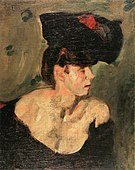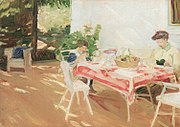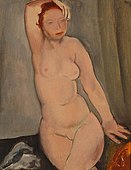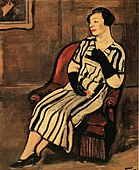Georges Kars
Georges Kars | |
|---|---|
 Self-portrait, 1929 (Musée d'art moderne et contemporain de Strasbourg) | |
| Born | |
| Died | 5 February 1945 (aged 62 or 64) Geneva, Switzerland |
| Nationality | Czech |
| Movement | School of Paris |
Georges Kars (Georges Karpeles or Georg Karpeles - Jiří Karpeles) (2 May 1880,[1][2] other sources 1882[3] – 5 February 1945[4]) was a Czech painter, part of the School of Paris movement,[5] known for his landscapes and nude paintings.
Life
Georges Kars was born to a German Jewish family in Kralupy. His father was a miller. When he was 18, Kars was sent to study in art in Munich with Heinrich Knirr and Franz von Stuck. From 1905 he travelled to Madrid where he met Juan Gris and immersed himself in the painting styles of Velasquez and Goya. In 1908, Kars arrived in Paris and settled in Montmartre at the time of the Cubist revolution, which also had an influence on his work,[6] and he met Suzanne Valadon and Maurice Utrillo.[7][8] His work was interrupted by the First World War which he spent on the Galician Front and in Russian captivity. He renewed his friendship with Pascin and frequented Chagall, Apollinaire, Max Jacob, the art critic Maurice Raynal and the Greek painter Demetrius Galanis.[9] He spent the summer of 1923 in Ségalas, Hautes-Pyrénées region, with Suzanne Valadon’s family.



An exhibition of his work took place at the Berthe Weill gallery in 1928.[10]
In 1933, he bought a house in Tossa de Mar near Barcelona. Along with a group of artists (Rafael Benet, Enric Casanovas and Alberto del Castillo) he inaugurated the Museu Municipal De Tossa Del Mar on 1 September 1935 as a modern art museum.[11] He returned to live in Caulaincourt street in Montmartre, Paris, in 1936.
When World War II started and Germany occupied Paris, he took refuge in Lyon, where he started to draw children with a sad expression.[12] In December 1942 he moved to the safety of his sister's home in Switzerland. Away from France, he made a large number of drawings and paintings depicting refugees seeking shelter.[13] He committed suicide in Geneva on 5 February 1945, most likely after receiving news of the deaths of relatives.
Florent Fels, who met Georges Kars before 1930, writes:
Although I lived in the strangest environment of Montmartre, next to artists with the most twisted mind, Kars stands there, singularly well balanced. He is so witty that he could be a cousin of Hoffmann's. We always expect him, just like the magician from Königsberg to create a burlesque miracle like turning the Sacré-Coeur church into an illuminated pool for the One Thousand and One Nights or to create some tales worthy of The Serapion Brethren.[14]
When his wife Nora died in 1966, the contents of his atelier were auctioned at the Palais Galliera in Paris. Pierre Levy, a French industrialist and art collector, and Oscar Ghez acquired an important part of the artworks. In 1983 the Modern Art Museum of Troyes staged the first Kars retrospective.
Gallery
-
Portrait of a lady in a hat, 1908
-
U svačiny, 1908
-
Still life with a green glass, 1914
-
Nudes (Murder of Innocents, Abduction of Sabinek), 1919
-
Seated Nude, 1921
-
Portrait of Mrs. Suvičová - Black gloves, 1933
-
Ráno, 1933
-
Self portrait, 1939
-
La robe pointillée, 1939
-
Landscape in Southern France
References
- ^ Geburtenmatrikel Velvary / Matriční záznam Velvary (1880). "Liste der Geborenen / Seznam narozených (register Velvary, list of births)".
- ^ "Georges Kars (2 May 1880, Kralupy, Central Bohemia – 6 February 1945, Geneva, Switzerland) Park in the City (Hamburg), 1906". jewishmuseum.cz. February 2012. Archived from the original on 7 November 2017. Retrieved 1 November 2017.
- ^ "Kars, Georges". KARS, Georges (1882 - 1945), Painter, pastellist, sculptor, lithographer. Oxford University Press. 31 October 2011. doi:10.1093/benz/9780199773787.article.B00097281. Retrieved 1 November 2017.
{{cite book}}:|website=ignored (help) - ^ Hersh Fenster, Nos artistes martyrs. Paris 1951, p. 200
- ^ "Georges KARS". Bureau d’art Ecole de Paris. 2 January 2019. Retrieved 26 November 2023.
- ^ "GEORGES KARS (1880 – 1945) – Early Works | Židovské muzeum v Praze".
- ^ Suzanne Valadon by Jeanne Champion
- ^ Mistress of Montmartre: a life of Suzanne Valadon by June Rose
- ^ Georges Kars by Florent Fels, Editions Le Triangle
- ^ "Les artistes de la Galerie B.Weill".
- ^ http://image-source.saatchi-gallery.co.uk/museums/museum-profile/Museu+Municipal+De+Tossa+De+Mar/2992.html
- ^ Au nom de l'art, 1933-1945: Exils, solidarités et engagements
- ^ Studies in Contemporary Jewry : Volume VI: Art and Its Uses: The Visual
- ^ Georges Kars by Florent Fels, Editions Le Triangle
Further reading
- Florent Fels. Georges Kars. Paris, Éditions Le Triangle (1930)
- Atelier Georges Kars 1880-1945. Aquarelles - Gouaches - Pastels - Sanguines - Peintures. Auction catalog Hotel Drouot (C. Robert) Paris 1966
- La vie et l'oeuvre de Georges Kars. Joseph Jolinon, Lyons Ed. Imp. Gle du Sud-est 1958
- Georges Kars, 1880-1945, Galerie Jean Tiroche (1967)
- Georges Kars Peinture et Dessins, Musée d'art moderne de Troyes, Paris, 1983
- CS1 errors: periodical ignored
- Articles with short description
- Short description matches Wikidata
- Articles needing cleanup from August 2022
- Articles with bare URLs for citations from August 2022
- All articles with bare URLs for citations
- Articles covered by WikiProject Wikify from August 2022
- All articles covered by WikiProject Wikify
- Use dmy dates from October 2016
- Articles with hCards
- Articles with FAST identifiers
- Articles with ISNI identifiers
- Articles with VIAF identifiers
- Articles with BNE identifiers
- Articles with BNF identifiers
- Articles with BNFdata identifiers
- Articles with CANTICN identifiers
- Articles with GND identifiers
- Articles with J9U identifiers
- Articles with LCCN identifiers
- Articles with NKC identifiers
- Articles with Musée d'Orsay identifiers
- Articles with RKDartists identifiers
- Articles with ULAN identifiers
- Articles with DTBIO identifiers
- Articles with SUDOC identifiers
- 1880s births
- 1945 suicides
- 1945 deaths
- People from Kralupy nad Vltavou
- 20th-century Czech painters
- Czech male painters
- Austro-Hungarian prisoners of war in World War I
- World War I prisoners of war held by Russia
- Suicides by Jews during the Holocaust
- Czech Jews who died in the Holocaust
- Suicides in Switzerland
- Jewish School of Paris









